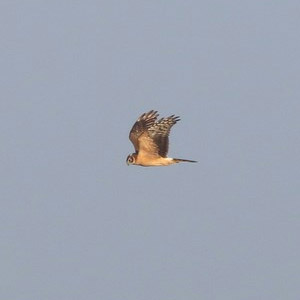Pratique | Identification
Un Busard pâle juvénile en Charente-Maritime : identification et réflexions

Busard pâle (Circus macrourus) juvénile femelle, Saint-Laurent-de-la-Prée (Charente-Maritime), janvier 2015.Photographie : Patrick Giulani
Introduction
Le Busard pâle (Circus macrourus) niche dans les régions sèches (steppes et cultures) du centre de l’Asie, au sud jusqu’à l’Iran et à l’ouest jusqu’en Dobroudja en Roumanie. Son aire d’hivernage est vaste, incluant l’Afrique tropicale (du Sénégal à l’Éthiopie et jusqu’en Afrique du Sud) et le sud de l’Asie (Inde, Pakistan) en passant par le Moyen-Orient (en Israël par exemple). En France, les observations de Busards pâles sont annuelles mais peu nombreuses : cette rareté est due à l’aire de répartition orientale de cette espèce, à la sous-prospection des cultures et des prairies (le biotope le plus proche des steppes naturelles et où il est donc le plus susceptible d’être vu) et à la difficulté d’identification des immatures et des femelles. Dans l’hexagone, la plupart des données sont concentrées entre mars et mai et en septembre -octobre et concernent surtout des mâles adultes, plus faciles à repérer.
Le 27 novembre 2014, un juvénile a été découvert dans les prairies humides de Saint-Laurent-de-la-Prée (Charente-Maritime), et il était encore présent le 21 janvier 2015. À l’occasion de ce long stationnement hivernal atypique, nous évoquons les critères permettant de distinguer les juvéniles des Busards pâle, cendré (Circus pygargus) et Saint-Martin (Circus cyaneus) et nous proposons quelques pistes de réflexion concernant la présence de cet oiseau. Nous remercions Antoine Barreau, Claude Champarnaud, Christophe Girardeau, Dominique Taudin et Patrick Giulani pour leurs photos.
Abstract
The Pallid Harrier (Circus macrourus) breeds in the steppes of central Asia, south to the edge of the Caucasus and west until Dobrogea in Romania. Its winter range is vast, including tropical Africa (from Senegal to Ethiopia and South Africa) and South Asia (India, Pakistan) through the Middle East (Israel for example). In France, the observations are annual but quite rare: this rarity is due to the eastern range of the species, the underprospection of fields and meadows where it is most likely to be watched and the difficulty of identification of immatures and females. In the hexagon, most of the data are concentrated in March-May and September-October and they mainly involve adult males which are easier to identify. A juvenile has been found the 24th of November 2014 in the flooded meadows of Saint-Laurent-de-la-Prée (Charente-Maritime, Western France), and it was still present the 21th of January 2015. In this article, we present the criteria for distinguishing juveniles Pallid, Hen and Montagu’s Harriers and we discuss about the presence of this long winter stay of this rare bird. We thank Antoine Barreau, Claude Champarnaud, Christophe Girardeau, Dominique Taudin and Patrick Giulani for their photos.
Poursuivez la lecture de cet article, en vous abonnant dès maintenant !
Découvrez les Archives d’Ornithomedia.com
Pour seulement 10,00 €TTC/an (ou 6,00 € les 6 mois)
Profitez de plusieurs centaines d’articles en accès illimité et sans aucun engagement.
Compléments
À lire aussi sur Ornithomedia.com
- Identifier le Busard pâle
- Identification du Busard pâle : deux cas déroutants
- À propos du long séjour d’une Buse féroce dans l’Aude durant l’hiver 2013-2014
- À propos de la migration printanière du Busard pâle
- Afflux de Pouillots à grands sourcils dans les îles Canaries durant l’automne-hiver 2013-2014
Dans la rubrique Observations d’Ornithomedia.com
Busard pâle (Circus macrourus)
À lire sur le web
Le site web www.faune-charente-maritime.org
Ouvrages recommandés
- Le Guide Ornitho de L. Svensson et al
- The Raptors of Europe and the Middle East: A Handbook to Field Identification de Dick Forsman
Sources
- Dick Forsman (1995). Field identification of female juvenile Montagu’s and Pallid Harriers. Dutch Birding (17). Pages 41-54. www.dickforsman.com/wp-content/uploads/2011/09/cirmac-pyg-ringtails1995dbvol17-p41-54.pdf
- Javier Blasco-Zumeta et Gerd-Michael Heinze. Montagu’s Harrier. Atlas de identification de las Aves de Aragón. http://aulaenred.ibercaja.es/wp-content/uploads/115_MontagusHarrierCpygargus.pdfHugues Dufourny (1996). Observation d’un Busard pâle (Circus macrourus) à Angre (Hainaut). Aves 33/1. http://www.aves.be/index.php?id=article_bulletin&tx_natbulletin_pi1[uid]=880
- William Clarck (1997). Identification of perched Montagu’s and Pallid Harriers. Birding World 10(7). Pages : 267-269. www.globalraptors.org/grin/researchers/uploads/155/id_of_perched_harriers_1997.pdf
- Asko Lõhmus (2011). Three-year periodicity in historical raptorpersecution
data: an indication of vole cycles? Estonian Journal of Ecology (60, 2). Pages :155-164. www.kirj.ee/public/Ecology/2011/issue_2/ecol-2011-2-155-164.pdf - Stephen Daly (2011) .Pallids performaing pefectly. Date : 3/11. Andalucian Guides. www.andalucianguides.com/blog/view/pallids_performing_perfectly
- Nils Vanduivendjik (2012). First-summer male undertakes post-juvenile moult in the Netherlands. Birding Frontiers. http://birdingfrontiers.com/2012/09/20/pallid-harrier-next-step-in-status-change/
- Juan Sagardia (2014). Apparent mixed pairing in Spain. Birding Frontiers.
http://birdingfrontiers.com/2014/05/21/pallid-x-montagus-harrier/ - Vladimir Galushin et al (2003). International Action Plan for the Pallid Harrier (Circus macrourus). Convention of the conservation of European wildlife and natural habitats. www.avibirds.com/saps/EU/Europe/EN/Pallid%20Harrier2002.pdf
- The Peregrine Fund. Pallid Harrier Circus macrourus. www.globalraptors.org/grin/SpeciesResults.asp?specID=8208
- Dick Forsman.com (2009). Another tough harrier! DickForsman.com. www.dickforsman.com/bird-identification/




 1 commentaire
1 commentaire
1 commentaire(s) sur ce sujet
Participer à la discussion !Corentin Bonnard
Moidieu-Détourbe
Posté le 18 janvier 2017
à noter que le 19 novembre 2014 à 7h48 un Busard pâle de 1ère année a été vu en migration à la pointe de l’aiguillon en sud Vendée. Seulement 8 jours avant qu’il soit découvert à Saint-Laurent-de-la-Prée. 35 km à vol d’oiseaux.